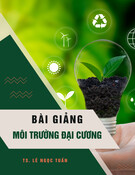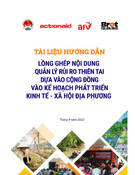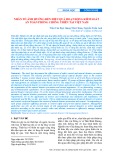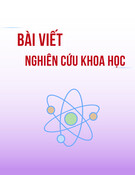
VNU Journal of Science: Earth and Environmental Sciences, Vol. 41, No. 1 (2025) 14-29
14
Original Article
The Effectiveness of Climate-smart Agriculture Practices in
Coffee Production at Dlie Ya Commune in Dak Lak Province
Doan Thi Nhung1, Dao The Anh2, Nguyen Thi Hai3,
Yuki Ishikawa - Ishiwata4, Nguyen Thi Hoang Ha1,*
1VNU Vietnam Japan University, Luu Huu Phuoc, Nam Tu Liem, Hanoi, Vietnam
2Vietnam Academy of Agricultural Sciences, Vinh Quynh, Thanh Tri, Hanoi, Vietnam
3VNU University of Science, 334 Nguyen Trai, Thanh Xuan, Hanoi, Vietnam
4Global and Local Environment Co-creation Institute (GLEC), Ibaraki University,
Ibaraki 310-8512, Japan
Received 20th June 2024
Revised 17th December 2024; Accepted 20th February 2025
Abstract: This study aimed to quantitatively assess the effectiveness of climate-smart agriculture
(CSA) practices in coffee production in Dlie Ya commune, Dak Lak province. A theme-based
framework and an indicator-based method with 23 indicators of five components (beneficiaries and
yield, enabling environment, natural resources, emission, and benefits and welfare) were used. Semi-
structured interviews with 107 local households were conducted. Data were coded, normalized to a
0-1 scale, and assessed, of which 1 refers to the highest effectiveness of CSA practices. Intercropping
and soil coverage (mulching) were the two most common CSA practices in the study area. The CSA
practices of intercropping and soil cover showed several advantages over not using these practices.
These benefits included increased coffee yield, more stable yield variability, and reduced use of
natural resources. The effectiveness score for intercropping was 0.66, significantly higher than the
score for no intercropping (0.61) (p < 0.001). Soil coverage had an effectiveness score of 0.68, which
was higher than no soil coverage (0.60) (p < 0.001). The results of this study indicate that
intercropping and soil cover are good CSA practices and should be promoted for broader adoption
among coffee farmers. Despite the results showing higher yields with the introduction of CSA,
farmers still need to consider comprehensive measures to make their decisions. Training workshops
organized by the local government might be essential to communicate the benefits of CSA practices
to local farmers.
Keywords: climate-smart agriculture, coffee, effectiveness, indicator, Vietnam.. *
________
* Corresponding author.
E-mail address: nth.ha@vju.ac.vn
https://doi.org/10.25073/2588-1094/vnuees.5171






























